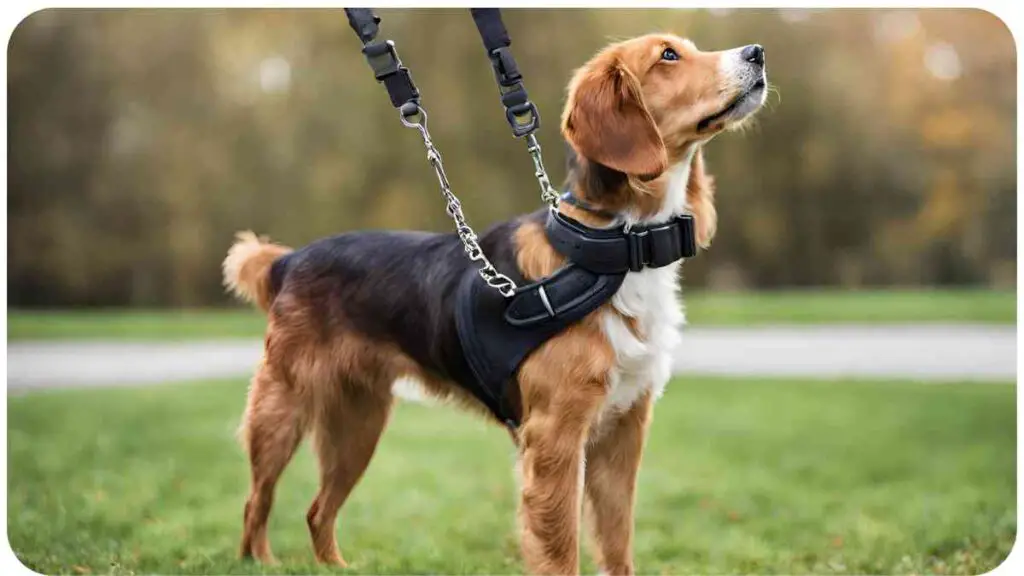Bark collars can be effective tools for training dogs to control their excessive barking. However, to ensure their effectiveness and your dog’s comfort, it’s crucial to adjust the sensitivity of the bark collar correctly.
In this guide, we’ll delve into the process of adjusting sensitivity on your dog’s bark collar, offering insights and tips for a smoother training experience.
| Takeaways |
|---|
| Proper sensitivity adjustment is crucial for effective bark collar training. |
| Understanding your dog’s behavior and environment helps in determining the appropriate sensitivity level. |
| Regularly monitor and adjust the sensitivity settings to ensure optimal performance. |
| Pair bark collar training with positive reinforcement techniques for better results. |
| Consult manufacturer guidelines and seek professional assistance if needed. |
2. Understanding Bark Collars

Bark collars come in various types, each utilizing different methods to deter excessive barking. Understanding these types is essential before delving into sensitivity adjustment.
When troubleshooting your cat’s GPS collar, ensure proper signal reception and accurate settings. Adjust common issues swiftly to prevent tracking errors and ensure your feline’s safety outdoors.
Types of Bark Collars
| Type | Description |
|---|---|
| Static Bark Collars | Emit a static correction when the dog barks excessively. |
| Citronella Spray Collars | Release a burst of citronella spray to deter barking. |
| Ultrasonic Bark Collars | Emit a high-pitched sound to distract the dog from barking. |
How Bark Collars Work
Bark collars are designed to detect barking through various sensors and deliver a correction to discourage further barking behavior.
3. Importance of Adjusting Sensitivity
Adjusting the sensitivity of your dog’s bark collar is crucial for several reasons.
Avoiding Overcorrection
Setting the sensitivity too high may result in the collar activating unnecessarily, which can confuse your dog and lead to discomfort. Conversely, if the sensitivity is too low, the collar may fail to correct excessive barking effectively.
Encountering issues with your rabbit’s Drinkwell fountain? Explore effective fixes and maintenance tips to resolve working tips promptly and ensure continuous hydration for your furry friend.
Ensuring Effective Training
Properly adjusting the sensitivity ensures that the collar responds appropriately to your dog’s barking behavior. This consistency is vital for effective training and behavior modification.
4. Factors Affecting Sensitivity Adjustment

Several factors influence the sensitivity adjustment process.
Dog’s Size and Breed
Smaller breeds may require lower sensitivity settings, while larger breeds may need higher levels of correction. Additionally, some breeds are more sensitive to certain correction methods than others.
Environmental Factors
External noises and environmental stimuli can affect the collar’s sensitivity. Adjustments may be necessary depending on the surroundings in which your dog will be wearing the collar.
Collar Fit
Ensuring the collar fits properly is essential for accurate sensitivity adjustment. A snug but comfortable fit ensures the sensors can detect your dog’s barking accurately.
5. Steps to Adjust Sensitivity
Adjusting the sensitivity of your dog’s bark collar requires a systematic approach to ensure optimal results.
Read the Manual
Before attempting to adjust the sensitivity, thoroughly read the manufacturer’s manual accompanying the bark collar. Each collar may have specific instructions and guidelines for sensitivity adjustment.
Curious about the waterproof features of PetSafe collars? Delve into how PetSafe collars withstand wet conditions, providing insights into their durability and functionality during outdoor activities with your pet.
Test Mode
Many bark collars come with a test mode that allows you to gauge the collar’s response without activating a correction. Use this mode to determine the appropriate sensitivity level for your dog.
Gradual Adjustment
Start with the lowest sensitivity setting and observe your dog’s response. If the collar fails to activate when your dog barks, gradually increase the sensitivity until you achieve the desired response.
Monitoring Your Dog’s Response
Throughout the adjustment process, closely monitor your dog’s behavior and reactions to the collar’s corrections. This feedback will help you fine-tune the sensitivity settings to suit your dog’s needs.
6. Troubleshooting Common Issues
Even with careful adjustment, you may encounter common issues with your dog’s bark collar.
Is your cat’s microchip door failing to recognize them? Investigate potential causes and solutions to address microchip door issues swiftly, ensuring seamless access for your feline companion while maintaining security at home.
Collar Not Responding
If the collar fails to activate when your dog barks, check the battery, collar fit, and sensor placement. Adjustments may be necessary to ensure proper functionality.
Continuous Correction
If the collar continues to activate excessively, despite adjustments, it may indicate a problem with the sensitivity settings or the collar itself. Reset the sensitivity to the lowest level and gradually increase it while observing your dog’s response.
False Activations
External noises or movements can trigger false activations in some bark collars. Minimize these occurrences by adjusting the collar’s sensitivity and ensuring a proper fit.
7. Tips for Effective Use

To maximize the effectiveness of your dog’s bark collar, consider the following tips:
Consistency in Training
Consistency is key to successful bark collar training. Ensure that all family members are on the same page regarding training methods and expectations.
Facing connectivity challenges with your Furbo dog camera? Navigate through troubleshooting techniques and connectivity solutions to restore setup tips promptly, ensuring uninterrupted monitoring and interaction with your canine companion.
Positive Reinforcement
Pair bark collar training with positive reinforcement techniques, such as treats and praise, to reinforce desired behaviors and encourage your dog’s cooperation.
Regular Maintenance
Regularly check the collar’s fit, battery levels, and sensitivity settings to ensure optimal performance. Clean the collar and replace batteries as needed to prevent malfunctions.
8. Conclusion
Adjusting the sensitivity of your dog’s bark collar is a crucial step in effectively training your dog to control excessive barking. By understanding the factors that influence sensitivity adjustment and following the proper steps, you can ensure a comfortable and effective training experience for your furry friend.
Remember to remain patient and consistent throughout the training process, and always prioritize your dog’s well-being and comfort. With the right approach, you can successfully curb excessive barking and strengthen the bond between you and your beloved pet.
Further Reading
Here are some additional resources to further enhance your understanding of bark collar sensitivity adjustment:
- Pro Tip: Bark Sensitivity Dial – Ultimate Bark Control: This article provides expert tips on effectively adjusting the sensitivity dial on bark collars for optimal training results.
- PetSafe Support: Bark Collar Set-Up: A comprehensive guide from PetSafe offering step-by-step instructions for setting up and adjusting bark collars.
- Bark Collar Manual (PDF): This downloadable manual offers detailed information on the sensitivity adjustment process and troubleshooting tips for bark collars.
FAQs
How do I know if the sensitivity on my dog’s bark collar needs adjusting?
The collar may be too sensitive if it frequently activates in response to harmless sounds or movements. Conversely, if your dog continues to bark excessively without correction, the sensitivity may be too low.
Can I adjust the sensitivity of my dog’s bark collar on my own?
Yes, most bark collars come with adjustable sensitivity settings that can be easily modified by following the manufacturer’s instructions.
How often should I check the sensitivity of my dog’s bark collar?
It’s recommended to check the sensitivity settings periodically, especially if you notice changes in your dog’s behavior or surroundings that may affect the collar’s performance.
Will adjusting the sensitivity of the bark collar hurt my dog?
No, adjusting the sensitivity of the bark collar should not cause any harm to your dog. However, it’s essential to monitor your dog’s response to ensure the correction is neither too harsh nor too mild.
What should I do if I encounter issues with adjusting the sensitivity of the bark collar?
If you experience difficulties adjusting the sensitivity or encounter other issues with your dog’s bark collar, refer to the manufacturer’s manual for troubleshooting tips or seek assistance from a professional dog trainer.

I’m Dr. Hellen James, a professional veterinarian with a deep interest in the ways that litter size affects the health of animals. I’ve spent years studying this subject and performing research on reproduction in many different kinds of creatures.

